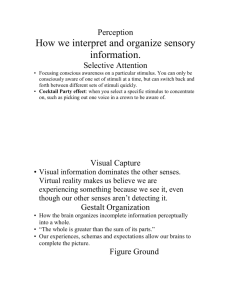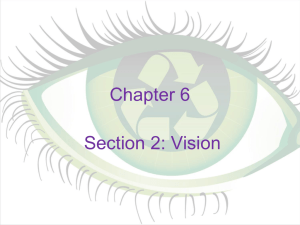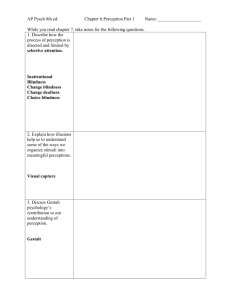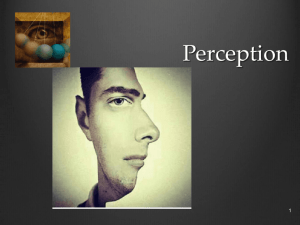Perception
advertisement
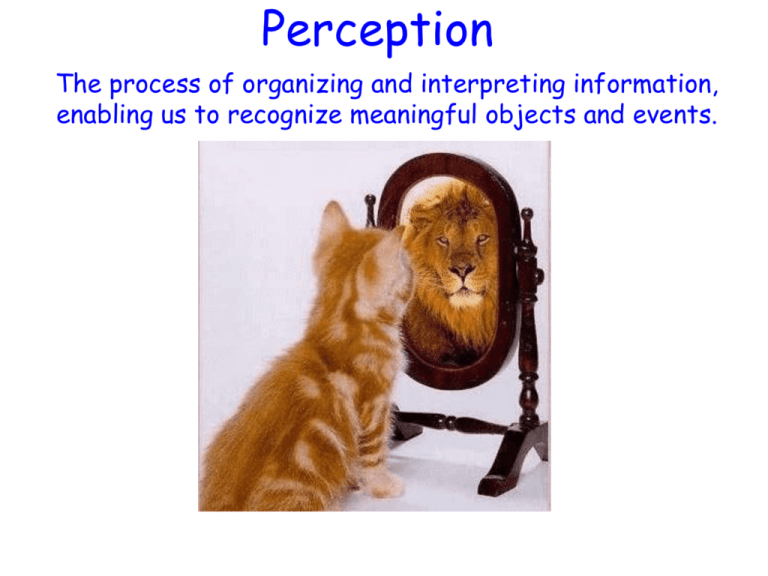
Perception The process of organizing and interpreting information, enabling us to recognize meaningful objects and events. Selective Attention • The focusing of conscious awareness on a particular stimulus. Cocktail-party phenomenon • The “cocktail party effect” describes the ability to focus one's listening attention on a single talker among a mixture of conversations and background noises, ignoring other conversations. – Form of selective attention. • Listening to music and studying? – Headphone activity. Cell Phones and Driving? • Texting while driving is now the leading cause of death among teenagers – surpassing drinking and driving. • More than 3,000 teens die each year in crashes caused by texting while driving. Why? • Turn to a partner and explain from a psychological theory, why your reaction time decreases by more than 35% when texting and driving. • How could we convince teens not to text and drive? Inattentional Blindness Try the following: • Card Trick • Basketball Game Inattentional Blindness • Failing to see visible objects when our attention is directed elsewhere. • Look at the FedEx truck in the next picture. See anything? • Now look again at the next photo. See if you notice it now. Show Brain Games “Pay Attention” (0-9:00) Illusions Ames Room Illusions of Perceived Size-Distance Parked Cars Ponzo Illusion Illusions of Perceived Size-Distance Muller-Lyer Illusion Illusions of Perceived Size-Distance Horizon Moon Illusions of Size-Distance Relationship High moon on a clear night. Other Illusions "Optical illusion disc (1833) which is spun displaying the illusion of motion of a ball with a wedge-shaped piece missing passing through a hoop and of a monkey swinging on branches of a tree and a zebra jumping through an opening between two trees in a circle at the outer edge of the disc." Gestalt Psychology • Gestalt means “an organized whole.” • These psychologists emphasize our tendency to integrate pieces of information into meaningful wholes. Gestalt Psychology • To perceive forms, we must organize the visual field into objects (figures) that stand out from their surroundings (ground). • This is figure-ground perception. Gestalt Psychology • Gestalt psychologists focused on how we GROUP objects together. • We innately look at things in groups and not as isolated elements. A form of Top-Down Processing. • Proximity (group objects that are close together as being part of same group). • Similarity (objects similar in appearance are perceived as being part of same group). • Continuity (objects that form a continuous form are perceived as same group). • Closure (we fill gaps in if we can recognize it). • Marching Band Example Gestalt Psychology Depth Perception • The ability to see objects in three dimensions although the images that strike the retina are two dimensional. • Allows us to judge distance. Depth Cues • Eleanor Gibson and her Visual Cliff Experiment for depth perception. • If you are old enough to crawl, you are old enough to perceive depth. • We see depth by using two cues that researchers have put in two categories: • Monocular Cues • Binocular Cues Monocular Cues • You really only need ONE eye to use these (used by artists to show depth). • Linear Perspective • Interposition • Relative size • Texture gradient • Relative Motion Monocular Cues • Interposition: if something is blocking our view, we perceive it as closer. • Relative Size: if we know that two objects are similar in size, the one that looks smaller is farther away. • Linear Perspective: parallel lines seem to converge with distance. Monocular Cues • Texture Gradient: the coarser it looks the closer it is. • Relative Motion: things that are closer appear to move more quickly. Binocular Cues • We need BOTH of our eyes to use these cues. • Retinal Disparity - as an object comes closer to us, the differences in images between our eyes becomes greater (Like the Sausage Finger trick). • Convergence - degree to which our eyes turn inward to focus on an object. Motion Perception • Stroboscopic effect (flip book effect). • Phi phenomenon (blinking neon lights; like the marquee in front of the school). Perceptual Constancy • Perceiving objects as unchanging even as illumination and retinal images changes. • • • • Types of Constancy Shape Constancy Size Constancy Lightness Constancy (ex. A white piece of paper indoors reflects considerably less light than does a black lump of coal outside on a bright, sunny day. Yet the paper looks white, and the coal black.) Sensory Deprivation • What happens when vision is restricted from birth? • If their sight is restored, they can perceive figure from ground and colors, but they lack the experience to recognize shapes, forms and complete faces. • Critical Period – for some aspects of sensory and perceptual development. Perceptual Adaptation • In vision, the ability to adjust to an artificially displaced or even inverted visual field. Perceptual Set • Mental predisposition to perceive one thing and not another. • What you see in the center picture is influenced by a perceptual set. Based on schemas. Face Schemas • The famous Mona Lisa . . . frown or smile? Context Effects • Based on the immediate context. • How you perceive the box in the following picture depends on the context defined by the rabbits. Human Factors Psychology • Human factors psychologists help others by: • Developing products that maximize usability. • Working to improve worker safety and efficiency. Extrasensory Perception • Extrasensory perception (ESP): the ability to perceive events without using normal sensory receptors. • Parapsychology: the field that studies ESP and other paranormal phenomena. Types of ESP – Telepathy: the ability to read minds – Clairvoyance: the ability to perceive objects or events – Precognition: the ability to predict the future – Psychokinesis: the ability to move objects There Is Little Scientific Evidence for Extrasensory Perception • Reasons for skepticism: – Many published ESP studies have used flawed research methodologies or failed to detect outright fraud by those they were testing.

